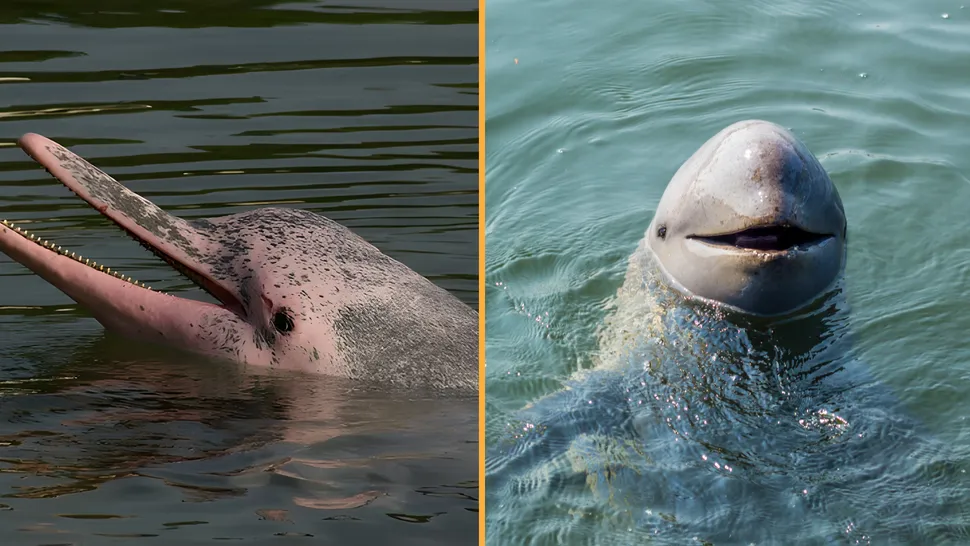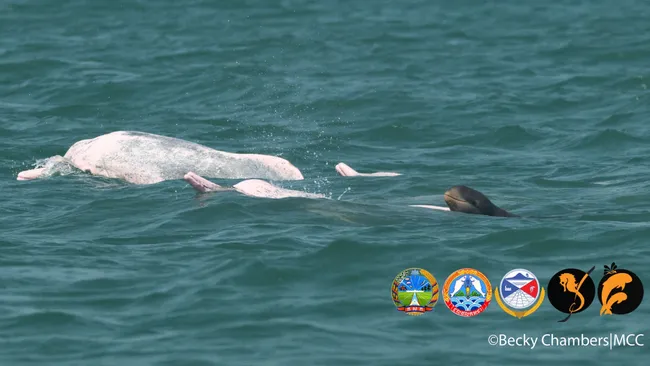Researchers captured an image of a baby Irrawaddy dolphin mingling with Indo-Pacific humpback dolphins off Cambodia’s coast.
A rare and endangered Irrawaddy dolphin calf was seen swimming with another dolphin species in Cambodia, puzzling scientists.
The Irrawaddy dolphin calf (Orcaella brevirostris) was likely with its mother among Indo-Pacific humpback dolphins (Sousa chinensis). The distinct appearance of Irrawaddy dolphins, which are dark gray with rounded faces, contrasted sharply with the pink, long-nosed Indo-Pacific humpback dolphins, making them stand out.
On May 31, Marine Conservation Cambodia (MCC) researchers announced the sighting, noting on Facebook that this interaction was “extremely unusual,” as these species typically only come together while foraging.

Becky Chambers, lead scientist at MCC’s Cambodian Marine Mammal Conservation Project, expressed excitement over spotting the calf but uncertainty about why the two species were together.
“It is a bit of a mystery,” Chambers remarked. “These are both highly threatened dolphin populations, and their interaction is, at this moment, neither definitively positive nor negative.” Irrawaddy dolphins, known for spitting water and assisting humans in fishing, face extinction threats partly due to entanglement in fishing gear. The exact number of wild Irrawaddy dolphins is unknown, but their population is significantly fragmented, according to the IUCN Red List.
On March 12, while conducting dolphin surveys off southern Cambodia, Chambers and her team first observed the young Irrawaddy dolphin calf. “We often see juveniles, but this was a newborn, which is a significant event,” she noted.
Although Irrawaddy dolphins can hybridize with Indo-Pacific humpback dolphins, it is extremely rare. This calf displayed all the physical traits of an Irrawaddy dolphin, suggesting it was born to Irrawaddy parents.
Both species exhibit alloparenting—caring for young that are not their own—which might occasionally extend to other species. However, it is unclear if the Indo-Pacific humpback dolphins intended to help or harm the calf. Chambers speculated that the Indo-Pacific dolphins might have tried to separate the mother and calf aggressively, possibly driven by competition. “I’m unsure if this was an aggressive interaction,” she commented.
It seems the calf survived its encounter with the Indo-Pacific humpback dolphins. On April 23, a colleague of Chambers likely spotted the calf again, following a lone Indo-Pacific humpback dolphin that joined a group of Irrawaddy dolphins. While the exact reasons for this behavior are unknown, Chambers believes it was the same calf previously seen with the Indo-Pacific dolphins.
“They didn’t have a good camera, so no photo ID could be taken at that time, but it is likely the same individual, which is good news because it means the calf is still alive,” Chambers said.
